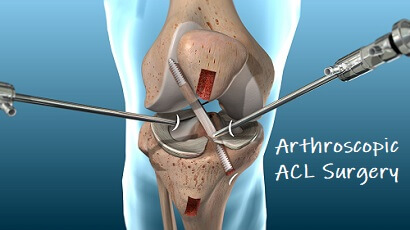- Home
- Arthroscopic Fixation Of ACL Fracture
Arthroscopic Fixation Of ACL Fracture
Fixation of Anterior Cruciate Ligament Avulsion Fracture
Controversy still exists regarding how to reduce and fix a displaced tibial avulsion fracture. Open reduction and internal fixation may lead to morbidity due to soft-tissue injury and arthrotomy. As a result, arthroscopic techniques are increasing in popularity. In the literature, sutures, K wires, and screws are suggested to be used as the fixation devices. Screws cannot be used in small or comminuted fractures, whereas K wires and sutures may not provide strong stability. Recently, with the advent of ultrahigh molecular weight polyethylene sutures like FiberWire, it has become possible to use it as the fixation device in even comminuted avulsion fractures with acceptable reduction stability. In this paper, we describe a simple arthroscopic technique using a FiberWire to manage the displaced tibial eminence avulsion fracture.

Types of Arthroscopic ACL Surgery
Arthroscopic ACL surgery aims to restore the functional stability of the knee while retaining full range of movement.
There are two types of arthroscopic ACL surgery depending on the extent of damage to the anterior cruciate ligament:
1. ACL Repair Surgery
Arthroscopic ACL repair surgery is usually done when the ligament has broken off from the bone (known as an avulsion) but is still intact. The ligament is reattached to the bone and held in place.
Repair is sometimes carried out if the ligament has partially torn. The surgeon sews the ligament back together so it can heal. However, there is a high failure rate so in most cases, it is better to go for a reconstruction rather than repair.
BOOK AN APPOINTMENT
“KNEEO Technique” For Knee Replacements
2. ACL Reconstruction
If there is more significant damage, or there are ongoing problems with pain and instability, the torn ligament is removed and replaced with a graft, usually taken from your hamstring or patellar tendon. This is known as arthroscopic ACL reconstruction surgery.
An ACL reconstruction is much more common than an ACL repair.
You can find out more about what the surgery involves, the recovery process and common problems associated with surgery in the ACL reconstruction section.
Preparing for Surgery
Performing surgery too quickly has been linked with an increased failure rate due to re-rupture of the new graft. Your surgeon will probably want to wait until:
- The swelling has reduced
- You have regained full range of movement at the knee
- You have built up the strength of the quadriceps and hamstring muscles
They may refer you for physio prior to your operation to get you started on a rehab programme. This will also have a positive impact on the recovery process.
What Happens During ACL Surgery?
With both types of arthroscopic ACL surgery, two or three small incisions are made at the side of the knee. A special camera (known as an arthroscope) is inserted through one hole so that the surgeon can see the extent of the damage.
Special tools (such as scissors or lasers) are then inserted through the other hole and used to repair or removed and replace any damaged tissue. The joint is then washed out with sterile fluid and closed.
What Happens After ACL Surgery?
Arthroscopic ACL surgery is not a quick fix. Both procedures will be followed by months of rehab to build up the strength and stability of the knee and retrain proprioceptive function.
You can find out more about arthroscopic ACL surgery in the ACL reconstruction section which looks in depth at what the surgery involves and the recovery and rehab process as well as common problems associated with the surgery.


